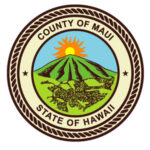Feb 9, 2011 | Community, Sustainability

Harlan Hughes
Hughes has retired now from the food and beverage industry, a background that helps explain his particular passion in giving back. He learned about volunteerism and serving the community from his mother, Lottie, who was a dedicated volunteer here on Maui well into her 80s. He also developed and directs the annual “Chefs on the Beach” fundraiser (netting $20,000 last year) which helps support several Maui nonprofits, and his work for the Food Bank serves as another remarkable example.
The Food Bank, headed by Executive Director Richard Yust, in turn leaves no stone unturned in its mission to mitigate hunger across the County. Whether it’s collecting goods from community food drives or retail and wholesale store donations, distributing perishable items through partner agencies in a timely manner, or working with local farmers to bring in donated nutritional fresh produce, about 140,000 pounds of food per month reaches needy families and individuals. “We’re all about partnerships,” says Yust. “By working together, we are able to create win-win situations.” About 90 community service agencies and faith-based organizations that run a total of 105 programs access the inventory of the Food Bank, and over 10,000 recipients each month benefit through these programs – and from the dedication of volunteers like Harlan Hughes.
Feb 2, 2011 | Community
 Leslie-Ann Yokouchi’s motto for her real estate business, Windermere Valley Isle Properties, runs: “If home is where the heart is, then community is where you’ll find our souls.” Leslie credits her father, Pundy, for instilling in her the importance of taking action, contributing to a strong community, and giving back. “The Maui Arts and Cultural Center was my Dad’s principal legacy to the community,” says Leslie, “but he was involved in so many non-profit agencies one way or another.” Leslie is continuing that tradition.
Leslie-Ann Yokouchi’s motto for her real estate business, Windermere Valley Isle Properties, runs: “If home is where the heart is, then community is where you’ll find our souls.” Leslie credits her father, Pundy, for instilling in her the importance of taking action, contributing to a strong community, and giving back. “The Maui Arts and Cultural Center was my Dad’s principal legacy to the community,” says Leslie, “but he was involved in so many non-profit agencies one way or another.” Leslie is continuing that tradition.
Leslie entered the real estate business in 1979, and in 1997, she opened her own agency, Aina Maui Properties. Last year, her company joined the national Windermere group. “At heart, we’re still a local company with core values that are based on our ’ohana,” says Yokouchi. With every transaction, her “citizen agents” make a donation to the company Foundation. In turn, the Foundation distributes funds to local non-profit agencies dedicated to helping homeless and low-income families. During the 2010 Holiday season, the Foundation provided meals to several Maui families through a program of Maui Economic Opportunity (MEO). Yokouchi plans an annual fundraising event to grow the Foundation’s work. Leslie’s agents are also asked to donate a Community Service Day; last year, agents took time out to beautify the surroundings of the Kaunoa Senior Center in Spreckelsville.
Leslie also devotes some of her time to behind-the-scenes work on boards of Maui non-profit organizations, including the Society for the Prevention of Cruelty to Animals (SPCA), which focuses on spay and neuter program education, and with the Maui Memorial Medical Center (MMMC) Foundation, which raises funds and awareness for healthcare services. The Foundation has been instrumental in securing a new cardiac unit at MMMC. Leslie is a long-time Board Member of Seabury Hall and is a committed advocate of the role education plays in preparing citizens who will play a productive role in our community. “Giving something back to the community often involves time, not just money,” observes Yokouchi.
Jan 26, 2011 | Community, Education
 If you have ever wondered what might happen if you mix together bright young minds, committed teachers and parents, and energetic community volunteers, then look no further than Molokai. Over the last few years, a transformation has been taking place on the island as teams of students have been winning awards and turning heads with their robotics, science and math accomplishments. One of the catalysts for forging partnerships, bringing funders and volunteers together, and facilitating success is robotics “team mom,” Kimberly Mikami Svetin.
If you have ever wondered what might happen if you mix together bright young minds, committed teachers and parents, and energetic community volunteers, then look no further than Molokai. Over the last few years, a transformation has been taking place on the island as teams of students have been winning awards and turning heads with their robotics, science and math accomplishments. One of the catalysts for forging partnerships, bringing funders and volunteers together, and facilitating success is robotics “team mom,” Kimberly Mikami Svetin.
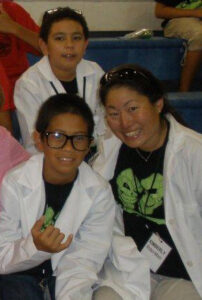 Svetin is a 13-year product of Molokai’s public schools and currently serves as school community council chair for Molokai Middle School. After leaving the island in 1987 to earn her bachelor’s degree from Pomona College, she returned in 2005 to manage her family’s business, Molokai Drugs, and raise her two young sons. She committed herself to sparking community-wide interest in developing the expertise of Molokai students in science, technology, engineering, and math (STEM) subjects, and she has a reputation for bringing people and projects together. Others active in the community, such as Barbara Haliniak, President of the Molokai Chamber of Commerce Foundation, pay tribute to Kimberly’s efforts. “I think we are witnessing a shift of momentum, and now there’s a mindset on the island that our students can go far, and compete not just against the best in the State and on a national level, but globally,” says Haliniak.
Svetin is a 13-year product of Molokai’s public schools and currently serves as school community council chair for Molokai Middle School. After leaving the island in 1987 to earn her bachelor’s degree from Pomona College, she returned in 2005 to manage her family’s business, Molokai Drugs, and raise her two young sons. She committed herself to sparking community-wide interest in developing the expertise of Molokai students in science, technology, engineering, and math (STEM) subjects, and she has a reputation for bringing people and projects together. Others active in the community, such as Barbara Haliniak, President of the Molokai Chamber of Commerce Foundation, pay tribute to Kimberly’s efforts. “I think we are witnessing a shift of momentum, and now there’s a mindset on the island that our students can go far, and compete not just against the best in the State and on a national level, but globally,” says Haliniak.
Our second-year robotics teams spent ten months preparing for their Maui competition and have distinguished themselves,” said Svetin. Three Molokai robotics teams–the Gleeks, the Kaunakakai Pharmers, and the Forget-Me-Nots–outperformed other Maui County teams to represent the district in the 6th Annual Hawaii First Lego League Championship on December 11th in Honolulu. Enthusiasm for robotics has spread to Molokai High School, which now has a VEX robotics team. Svetin’s latest endeavor is to bring graduate students and instructors from the University of Hawaii-Manoa to mentor 300 students for Molokai Math Day on February 26th.
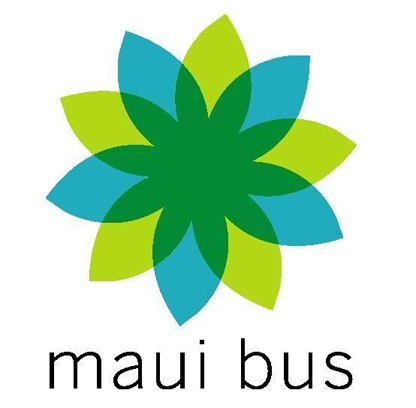
Jan 13, 2011 | Community, Sustainability
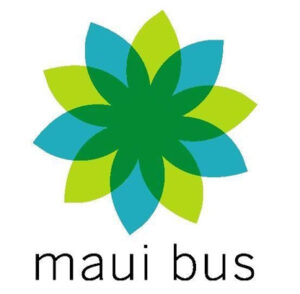 For many of Maui’s residents, it’s hard now to remember what life was like before the current public bus system got off the ground in 2004. That was shortly after the initial Focus Maui Nui civic engagement process had identified addressing infrastructure challenges as a top priority in our community. Latest ridership figures show that in 2010, an average of more than 6,000 trips are taken each day by bus. Clearly, the system is addressing the needs of a significant number of residents.
For many of Maui’s residents, it’s hard now to remember what life was like before the current public bus system got off the ground in 2004. That was shortly after the initial Focus Maui Nui civic engagement process had identified addressing infrastructure challenges as a top priority in our community. Latest ridership figures show that in 2010, an average of more than 6,000 trips are taken each day by bus. Clearly, the system is addressing the needs of a significant number of residents.
The bus system is operated by the County of Maui in part through Federal support. “The uncertainty regarding Federal “earmark” funding represents a major challenge in the coming months to maintaining our successful public bus system,” says Jo Anne Johnson, the incoming Director of the County’s Department of Transportation. Service is provided by Roberts Hawaii and is available in and between communities in Central, South, West and Upcountry Maui. 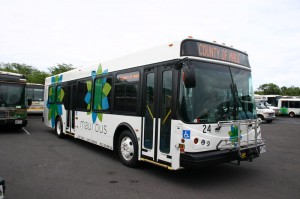 The bus system operates seven days a week, including holidays, and costs $1 per boarding, with daily and monthly passes also available. The system also features a commuter service (costing $2) designed for early morning and evening travelers to/from Wailea and Kapalua. All route and fare information as well as schedules are posted on the County website at www.mauicounty.gov/bus
The bus system operates seven days a week, including holidays, and costs $1 per boarding, with daily and monthly passes also available. The system also features a commuter service (costing $2) designed for early morning and evening travelers to/from Wailea and Kapalua. All route and fare information as well as schedules are posted on the County website at www.mauicounty.gov/bus
One further windfall from the increase in public transit use is the reduction in greenhouse gas emissions and savings in imported fossil fuel as a result of passengers switching from using cars. “The higher gas prices have risen, the more passengers are choosing to ride the bus,” says Jo Anne Johnson. The system represents a promising step towards greater island sustainability.
Do you use the Public Bus system? How often?
Dec 29, 2010 | Community
 The Chinese astrological symbol of the coming new year is appropriate for Maui County, Hawaii and the nation: 2011 will be the Year of the Rabbit, to be celebrated on the new moon on February 3rd. Chinese tradition holds the rabbit as a symbol of hope, an amiable, sensitive, modest and merciful pet of the moon goddess Chang’e.
The Chinese astrological symbol of the coming new year is appropriate for Maui County, Hawaii and the nation: 2011 will be the Year of the Rabbit, to be celebrated on the new moon on February 3rd. Chinese tradition holds the rabbit as a symbol of hope, an amiable, sensitive, modest and merciful pet of the moon goddess Chang’e.
For hope in our community, we need look no further than our children, who inspire us by their achievements, their adaptability, and their willingness to learn. In school, on the sports field, and in the community, we see them leading by example and setting the bar higher than ever. On environmental issues in particular, our youth are leading the way for sustainable solutions.
All of us can learn from the optimism of our children, and their tireless quest to understand the world around them. In the moments of their discoveries, we can celebrate with them, and experience the time-honored adage that “hope springs eternal”.
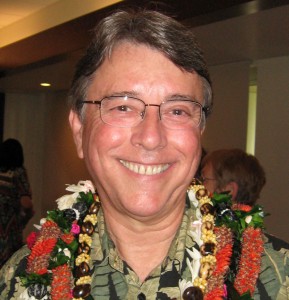
Dec 22, 2010 | Community
 Meeting human needs is a core Focus Maui Nui community value, and providing our less fortunate keiki with presents at Christmas time certainly meets this priority. We can take pride that our community has already proved more generous than ever this year.
Meeting human needs is a core Focus Maui Nui community value, and providing our less fortunate keiki with presents at Christmas time certainly meets this priority. We can take pride that our community has already proved more generous than ever this year.
One of the toy drives is coordinated by the Friends of the Children’s Justice Center of Maui, through an impressive partnership of businesses, organizations, and individuals. This year, more than 1,500 abused and neglected children or those currently in the
judicial system represented by 25 Maui agencies will benefit from the community’s generosity and receive a toy or gift this Christmas.
The toy drive programs are not just about gifts; they demonstrate the compassion of our community and express the underlying message to our keiki that they are not alone, and that there are many who care and want the best for them. “It’s a very positive
message that’s not lost on our children,” observes Randy Echito, Executive Director of the Friends of the Children’s Justice Center. “It’s especially appropriate at Christmas time, when the message is love for others.”
Among the agencies supported by the Friends’ gift giving program are Child Welfare Services (Department of Human Services), Child and Family Service, Maui Family Support Services, Maui’s homeless shelters, and Women Helping Women.
Other toy drives on Maui include the U.S. Marine Corps Toys for Tots program, which is administered on Maui by the Salvation Army, which distributed over 7,000 toys in Maui County during the Christmas season in 2009. The Boys and Girls Clubs of Maui, A Keiki’s Dream, the Valley Isle Community Federal Credit Union are among other organizations that also fill a very special need for thousands of our keiki at this special time of year.
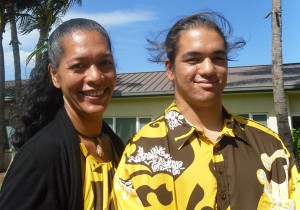
Dec 8, 2010 | Community

Pūlama Collier with her son Kia‘i Collier, a Kula Kaiapuni senior at King Kekaulike High School.
“Our public schools have been a mainstay for maintaining the consciousness of Hawaiian traditions without the community knowing it,” reflects Pūlama Collier, State Resource Teacher with the Department of Education for Hawaiian Language Immersion Program at King Kekaulike High School.
The immersion program on Maui, Kula Kaiapuni, has been an integral part of preserving Hawaiian culture on the island since 1989, when its first Kindergarten class began at Paia School. Today, there are about 220 students participating in Hawaiian language immersion classes at 4 public schools on Maui: Two at the elementary level (Paia School and Princess Nahienaena Elementary in Lahaina); Kalama Intermediate (Makawao); and King Kekaulike High School (Pukalani).
Statewide, there are 26 language immersion sites, with each island and community offering different models. In some cases, on Oahu and the Big Island, whole schools offer Hawaiian language immersion. On Maui, Kula Kaiapuni is “a school within a school”, as Pūlama observes, with certain classes offering instruction in all subjects in the medium of the Hawaiian language. Within the program, English language arts as a subject is introduced at the 5th grade level to ensure bilingual skills. Kula Kaiapuni, mandated by the State Constitution, is offered by the Department of Education to all families that choose it for their children.
Last week, Kula Kaiapuni students from all four Maui school sites participated in Na Mele O Maui, the annual Hawaiian Song and Art competition, held at the Maui Arts and Cultural Center. They distinguished themselves by winning either first or second place in the music categories.
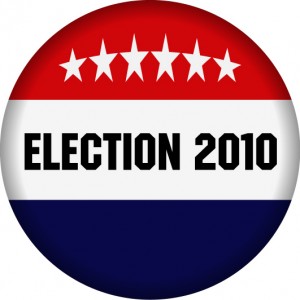
Nov 11, 2010 | Community
 Elections represent the will of citizens and election year 2010 was no different.
Elections represent the will of citizens and election year 2010 was no different.
Congratulations are due to candidates who will be sworn in to offices in Maui County, the Hawaii State Legislature, the 5th floor of the State Capitol and in Congress, but also to the candidates who offered voters a choice in ideas, philosophy and records.
The results will mean change in the Maui County Council and Hawaii State Legislature, in the Maui mayor’s seat and in the governor’s office. The results also mean change in many state and county departments as new appointees take over as directors and managers.
But if campaign slogans mean anything, there will be no change to perpetuation of core community values espoused by the constituency of Focus Maui Nui.
With the incoming leaders of the State of Hawaii, voters can be assured of attention to quality education as selection of members of the Board of Education is turned over to the new governor under the constitutional amendment approved by voters. Even as they differed on how to achieve the goals, returning incumbents and successful challengers all voiced support for values articulated by the participants of the Focus Maui Nui process: fostering quality education, preserving the Islands’ environmental and cultural resources, promoting targeted economic development and meeting the social and infrastructural needs of the community.
Those values are essential components of a healthy future for Maui Nui. The Focus Maui Nui process will continue to pursue consensus on strategies that provide quality opportunities for the residents of Maui County.
We look forward to the work ahead.
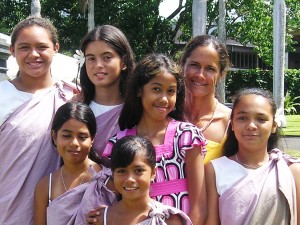
Nov 4, 2010 | Community
 Meeting human needs and preserving local culture are twin core values espoused by our community through the Focus Maui Nui process. Sharon Balidoy, a social worker at Queen Lili`uokalani Children’s Center (QLCC) in Wailuku, is a prime example of a practitioner active on both fronts, making profound contributions to the community.
Meeting human needs and preserving local culture are twin core values espoused by our community through the Focus Maui Nui process. Sharon Balidoy, a social worker at Queen Lili`uokalani Children’s Center (QLCC) in Wailuku, is a prime example of a practitioner active on both fronts, making profound contributions to the community.
QLCC is one of ten units statewide founded by the Queen Lili`uokalani Trust; the trust was founded over a century ago. “The work of the Children’s Center is to offer support and counseling services for Hawaiian orphans and their `ohana,” says Balidoy. “Family strengthening services are also provided to children living apart from their biological parents.”
Central to the mission of QLCC is perpetuation of Hawaiian culture and spirituality, and at the Wailuku Center, this means activities such as crafts, music, dance, and site visits to instill a sense of place. Balidoy estimates that QLCC reaches over a thousand children on Maui. “Our staff consists mostly of social workers working in specific communities, and an important aspect of our work is functioning as an effective team”, says Balidoy.
Balidoy is an expert on teamwork – she is a highly-respected competitive outrigger canoe paddler and helped establish Lae`ula O Kai canoe club almost 20 years ago, based at Kanaha Beach Park in Kahului. “Club members have put a lot of work into Park improvements, observes Balidoy. “Participating in community work days and keeping cultural traditions in mind are cornerstones of the club’s activities.”
Over the years, Balidoy has also been intimately involved in hula – she founded the Hālau Hula Alapa`i I Maluuluolele – “another one of my families,” she chuckles. “I studied under my mother, and for my sister and I, hula was a way of life. Now we both teach. The chants and hula are not about competition or seeking perfection. We practice out of respect for our ancestors and to understand their ways and the places they knew and memorialized.” Balidoy leads classes in Lahaina and Paukukalo.



 Svetin is a 13-year product of Molokai’s public schools and currently serves as school community council chair for Molokai Middle School. After leaving the island in 1987 to earn her bachelor’s degree from Pomona College, she returned in 2005 to manage her family’s business, Molokai Drugs, and raise her two young sons. She committed herself to sparking community-wide interest in developing the expertise of Molokai students in science, technology, engineering, and math (STEM) subjects, and she has a reputation for bringing people and projects together. Others active in the community, such as Barbara Haliniak, President of the Molokai Chamber of Commerce Foundation, pay tribute to Kimberly’s efforts. “I think we are witnessing a shift of momentum, and now there’s a mindset on the island that our students can go far, and compete not just against the best in the State and on a national level, but globally,” says Haliniak.
Svetin is a 13-year product of Molokai’s public schools and currently serves as school community council chair for Molokai Middle School. After leaving the island in 1987 to earn her bachelor’s degree from Pomona College, she returned in 2005 to manage her family’s business, Molokai Drugs, and raise her two young sons. She committed herself to sparking community-wide interest in developing the expertise of Molokai students in science, technology, engineering, and math (STEM) subjects, and she has a reputation for bringing people and projects together. Others active in the community, such as Barbara Haliniak, President of the Molokai Chamber of Commerce Foundation, pay tribute to Kimberly’s efforts. “I think we are witnessing a shift of momentum, and now there’s a mindset on the island that our students can go far, and compete not just against the best in the State and on a national level, but globally,” says Haliniak.







